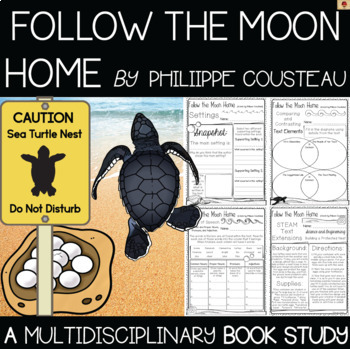Follow the Moon Home {A Book Study Set}
- PDF
Description
This multidisciplinary book study set, based on the title: Follow the Moon Home, by Philippe Cousteau, will help your students to grasp the concept of sea turtle conservation and preservation while completing several hands-on STEAM activities, games, and lessons, plus a fully comprehensive review and reflection pack to go alongside the pages within this book! Get your class excited to learn with the following included lessons (SEE THE PREVIEW FOR A MORE IN DEPTH LOOK AT ALL THAT THIS SET INCLUDES):
An Optional Packet Cover
Reading Comprehension Lessons on:
Pre-Reading Questions
Skim the Illustrations/Listen to the Synopsis Read Aloud to Make/Record Predictions
After I Read Reactions
Vocabulary
Main Character, Character Traits
Main Character, Growth and Life Events Throughout Text
Plot Sequencing, Main Idea
Main Setting, Additional Settings
Comprehension Questions
Compare/ Contrast
Story Summarizing w/Comic Strips
Story Summarizing w/Sections for Opinions
Grammar and Writing Extensions on:
Common and Proper Nouns, Pronouns, Adjectives, Prepositions, Verbs, Adverbs, and Conjunctions (using text words)
Cause and Effect in Text
Opinion Writing
Expository Writing
Narrative Writing
Persuasive Writing
Teacher's Choice Writing
Poetry on:
Sea Turtle Facts Haiku
Plot Narrative Poetry
My Own Way to Solve a Problem Shape Poem
Beyond the Text: Science and Conservation Connections on:
Sea Turtle Conservation Groups Passage, a Comprehension Question, a Grammar Challenge, and a Drawing
Interesting Sea Turtle Facts Passage, a Comprehension Question, and a Drawing
Conservation Connections (newspaper activity - just like in the text - informing and encouraging readers to “do their part” to protect baby sea turtles).
STEAM Extensions on:
SCIENCE (and ENGINEERING) Experiments: (sand observations, building a solution to protect nests, turtle stacking balancing challenge, and a sea turtle camouflage activity. Each experiment contains both directions and a reflection space.
TECHNOLOGY: Virtual Field Trip (Comes with links and a reflection page)
Sea Turtle Facts and Habitats Research
Library with Technology Connections.
ART: Center Signs (color/black and white, with ideas for your kids to be creative using ANY supplies that you have - include several recycled items, like old paper, milk cartons, bottles, etc!), and Story Elements Bookmarks
MATH (with TECHNOLOGY!): Drawing (all 7 Species) Life-Sized Sea Turtles (Using the internet/books, a tape measure and a piece of chalk, students will draw life sized sea turtles. Included is a fact-finding sheet, plus a reflection sheet).
Just for Fun Activities including:
2 Word Searches
1 Crossword Puzzle
2 Card Games
A Group Theater Project
I WILL BE ADDING ON MANY MORE ENVIRONMENTAL SCIENCE BASED BOOK STUDIES THIS YEAR! FOLLOW ALONG OR SEND ME A QUESTION WITH SPECIFIC BOOK TITLES THAT YOU MIGHT NEED RESOURCES FOR WITHIN THIS CATEGORY!





